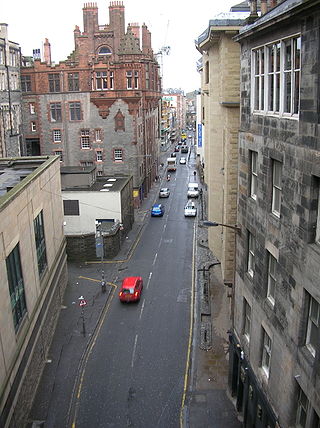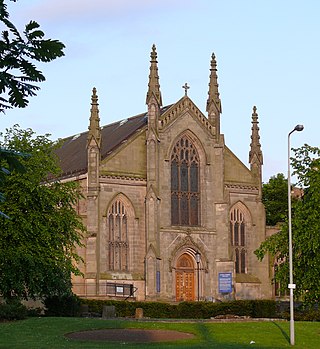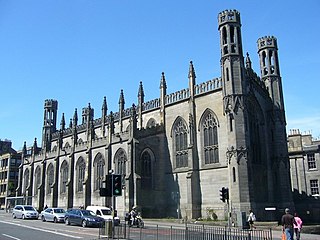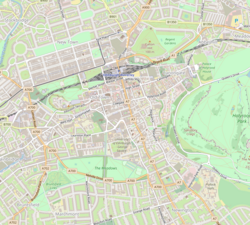
The Cowgate is a street in Edinburgh, Scotland, located about 550 yards (500 m) southeast of Edinburgh Castle, within the city's World Heritage Site. The street is part of the lower level of Edinburgh's Old Town, which lies below the elevated streets of South Bridge and George IV Bridge. It meets the Grassmarket at its west end and Holyrood Road to the east.

The Archdiocese of Southwark is a Latin Church archdiocese of the Catholic Church in England. It is led by the Archbishop of Southwark. The archdiocese is part of the Metropolitan Province of Southwark, which covers the South of England. The Southwark archdiocese also makes up part of the Catholic Association Pilgrimage.

The Metropolitan Cathedral of Our Lady of the Assumption, also known as St Mary's Metropolitan Cathedral, is a Roman Catholic church in Edinburgh, Scotland. It is the seat of the Archbishop of Saint Andrews and Edinburgh and the mother church of Scots Catholicism. The cathedral church is located at the East End of New Town in the city center.

St Paul's and St George's Church is an evangelical church of the Scottish Episcopal Church in central Edinburgh, Scotland. It is located on the corner of Broughton Street and York Place in the east end of Edinburgh's New Town, and is protected as a category A listed building.

St. Alphonsus Liguori "Rock" Catholic Church is an historic Black Catholic church in St. Louis, Missouri, founded in 1867. It is associated with the Redemptorist Order.
Hibernian Park was the home ground of the Scottish football club Hibernian from 1880 until the club's dissolution in 1891. When the club was reformed in 1892, the club took out on a lease on a site which became known as Easter Road. Hibernian Park was also located in the Easter Road area; in fact, it was closer to Easter Road itself than the present stadium because it was on the site of what is now Bothwell Street.

Reginald Francis Joseph Fairlie LLD was a Scottish architect. He served as a commissioner of RCAHMS and on the Ancient Monuments Board for Scotland.

St. Patrick's Church is the only English-speaking parish in the Archdiocese of Quebec, located in Quebec City, Quebec, Canada. Founded in 1832, the parish has occupied several different buildings as the population of English-speaking Catholics, primarily Irish, in Quebec City grew or declined.
The University of St Andrews Catholic Chaplaincy, known as Canmore, houses the Chaplaincy to Catholics at the University of St Andrews. The current chaplain is the Reverend Father Michael John Galbraith, who is also the Parish Priest.

Stephen Robson is the retired bishop of the Roman Catholic Diocese of Dunkeld. From 2012 to 2014 he was auxiliary bishop of the Archdiocese of St Andrews and Edinburgh.

Gillis Centre, formerly Gillis College and founded as St Margaret's Convent and School, is a complex of buildings situated close to the city centre of Edinburgh, Scotland. The history of the site can be traced back to the 15th century. The original building housed many literary figures of the eighteenth century, from 1834 it served as a convent and from 1986 to 1993 it was Gillis College, the seminary for the Roman Catholic Church in Scotland. It currently provides offices for the Curia of the Archdiocese of St Andrews and Edinburgh.

Church architecture in Scotland incorporates all church building within the modern borders of Scotland, from the earliest Christian structures in the sixth century until the present day. The early Christian churches for which there is evidence are basic masonry-built constructions on the west coast and islands. As Christianity spread, local churches tended to remain much simpler than their English counterparts. By the eighth century more sophisticated ashlar block-built buildings began to be constructed. From the eleventh century, there were larger and more ornate Romanesque buildings, as with Dunfermline Abbey and St Magnus Cathedral in Orkney. From the twelfth century the introduction of new monastic orders led to a boom in ecclesiastical building, often using English and Continental forms. From the thirteenth century elements of the European Gothic style began to appear in Scotland, culminating in buildings such as Glasgow Cathedral and the rebuilt Melrose Abbey. Renaissance influences can be seen in a move to a low-massive style that was probably influenced by contacts with Italy and the Netherlands.

Sacred Heart, Edinburgh, formally known as the Catholic Church of the Sacred Heart of Jesus, is a Roman Catholic church run by the Society of Jesus, close to the city centre of Edinburgh, Scotland, United Kingdom. It is situated in Lauriston, midway between the Grassmarket and Tollcross, on the edge of Edinburgh’s historic Old Town. The church building was opened in 1860 and is a category A listed building.

Canon Edward Joseph Hannan (1836–1891) was an Irish-born priest, mainly remembered as the founder of Hibernian Football Club in Edinburgh.

St Peter's Church is a parish of the Roman Catholic Church in the Morningside district of Edinburgh, Scotland, within the Archdiocese of St Andrews and Edinburgh.

St Mary Star of the Sea (Leith) Church is a Roman Catholic parish church in Edinburgh, Scotland. It is situated on Constitution Street in the Leith district and staffed by the Missionary Oblates of Mary Immaculate.

St Joseph's Church, Sighthill,, is a Roman Catholic church situated in Broomhouse, in the west of Edinburgh, Scotland. The parish boundary extends to Broomhouse, Parkhead, Saughton, Sighthill, Gorgie and further.

St Mary's Monastery is an ecumenical Christian spirituality and retreat centre in Kinnoull, Perth, Scotland. It was built in 1868 by the Redemptorists. Until 1971, it also served as a novitiate for the Redemptorists. In 1870, the church and shrine, Our Lady of Perpetual Help, was built within the grounds. It is located on Hatton Road, to the east of Kinnoull, on the edge of Kinnoull Hill, overlooking the city of Perth. The building has been registered as a category B listed building by Historic Environment Scotland, and was the first Roman Catholic monastery established in Scotland since the Reformation.

Our Lady of the Annunciation Church is a Catholic parish church next to Bishop Eton Monastery in Childwall, Liverpool. It was built from 1857 to 1858 by the Redemptorists and was designed by E. W. Pugin. It is on the Woolton Road, opposite the Hope Park campus of Liverpool Hope University and close to Our Lady's Bishop Eton Primary School. It is a Grade II* listed building.

St Albert's Catholic Chaplaincy is the Roman Catholic chaplaincy for the University of Edinburgh. It started in 1931, when the Dominican Order moved into the house. It is located at 23 and 24 George Square, south of the city centre, and north of The Meadows. The original building is category A listed and the chapel, built in 2012, won an award for architectural excellence from the Royal Institute of British Architects.





















